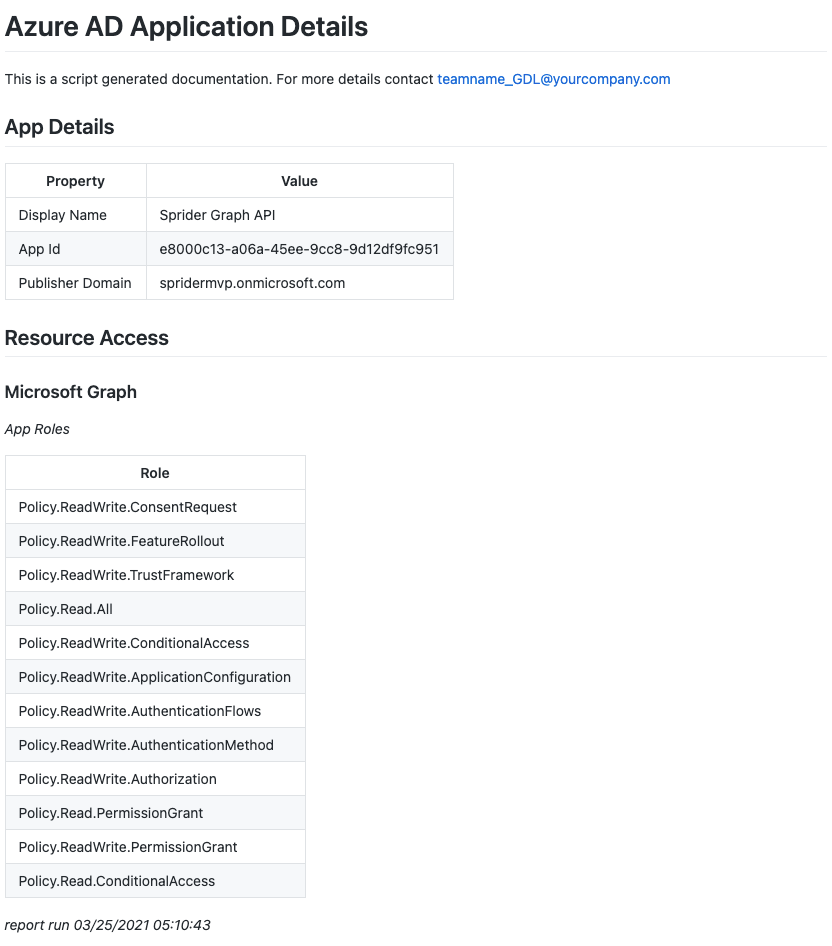Your organization likely has hundreds of Azure AD Applications. And with the constant addition, development and subset of new applications with various access points, it becomes imperative to use a script that streamlines the documentation process and helps creates technical documentation for every registered application. And that’s where the following script steps in.
What is Azure Active Directory?
Azure Active Directory is an Identity and Access Management (IAM) system. It provides a single place to store information about digital identities. You can configure your applications to use Azure AD as the place where user information is stored.
Advantages of generating documentation for Azure AD Applications
- Improves the experience for developers using your Azure AD Applications
- Decreases the amount of time spent on-boarding developers and application integration partners.
- Leads to good maintenance and quicker updates.
- API permissions, scopes, roles help developers and integration partners to understand the Azure AD Application and know what it can do
- Decreases the amount of time spent on decoding unexpected errors when using it.
In this article, I have attached a PowerShell script that takes the details of the given Azure AD Applications as input and creates readable markdown documentation that you can share with developers and integration partners using the simple use of Azure’s CLI commands.
Prerequisites
- Azure CLI
- Azure AD Applications registered in Azure tenant
- Azure Application Administrator / Developer role
- Login to Azure using Azure CLI before executing following script
Note - This code has not been optimized and is for demo purpose. You might need to modify the code as per your requirements.
PowerShell Script
function GetTenantId() {
$accountDetails = az account list | ConvertFrom-Json
return $accountDetails.tenantId
}
function GetAadApplications() {
return (az ad app list --all) | ConvertFrom-Json
}
function GenerateDocumentation($aadApplications) {
$progressCountApp = 1;
ForEach ($appInfo in $aadApplications) {
Write-Progress -Id 0 -Activity "Generating Documentation for the App: $($appInfo.displayName)" -Status "App $progressCountApp of $($aadApplications.length)" -PercentComplete (($progressCountApp / $aadApplications.length) * 100)
$outputDocumentPath = -join ($outputFolderPath, "\" , $appInfo.displayName, ".md")
$fragments = @()
$fragments += "# $($docTitle)`n"
$fragments += "$($docDescription)`n"
$fragments += "## App Details"
$fragments += "| Property | Value |"
$fragments += "| ------ | ------ |"
$fragments += "|Display Name|$($appInfo.displayName)|"
$fragments += "|App Id|$($appInfo.appId)|"
$fragments += "|Publisher Domain|$($appInfo.publisherDomain)|"
$fragments += "`n## Resource Access"
ForEach ($resource in $appInfo.requiredResourceAccess) {
$currentResource = (az ad sp show --id $resource.resourceAppId) | ConvertFrom-Json
$resourceName = $currentResource.displayName
if (![string]::IsNullOrEmpty($resourceName)) {
$fragments += "`n### $($resourceName)"
}
if ($resource.resourceAccess) {
$fragments += "`n_App Roles_"
$fragments += "| Role |"
$fragments += "| ------ |"
$appRoles = (az ad sp show --id $resource.resourceAppId --query "appRoles[].{Value:value, Id:id}") | ConvertFrom-Json
ForEach ($access in $resource.resourceAccess) {
$appRole = ($appRoles | Where-Object { $_.Id -eq $access.id })
$appRoleName = $appRole.Value
if (![string]::IsNullOrEmpty($appRoleName)) {
if (![string]::IsNullOrEmpty($appRoleName)) {
$fragments += "|$($appRoleName)|"
}
}
}
}
if ($resource.oauth2Permissions) {
$fragments += "`n_OAuth2 Permissions_"
$fragments += "| Permission |"
$fragments += "| ------ |"
$oauth2Permissions = (az ad sp show --id $resource.resourceAppId --query "oauth2Permissions[].{Value:value, Id:id}") | ConvertFrom-Json
ForEach ($oauth2Permission in $resource.oauth2Permissions) {
$appOauth2Permission = ($oauth2Permissions | Where-Object { $_.Id -eq $oauth2Permission.id })
$appOauth2PermissionName = $appOauth2Permission.Value
if (![string]::IsNullOrEmpty($appOauth2PermissionName)) {
$fragments += "|$($appOauth2PermissionName)|"
}
}
}
}
$fragments += "`n_report run $(Get-Date)_"
$fragments | out-file -FilePath $outputDocumentPath
$progressCountApp++
}
Write-Progress -Id 0 -Activity " " -Status " " -Completed
}
$docTitle = "Azure AD Application Details"
$docDescription = "This is a script generated documentation. For more details contact teamname_GDL@yourcompany.com"
$outputFolderPath = $PSScriptRoot
$aadApplications = GetAadApplications
GenerateDocumentation $aadApplications
Output

I would like to thank Jayakumar Balasubramaniam for the support he provided to review and finalize this script.
